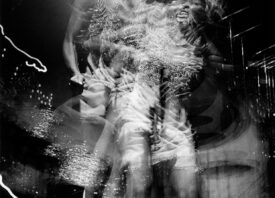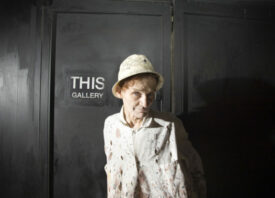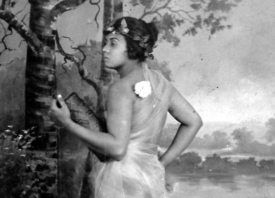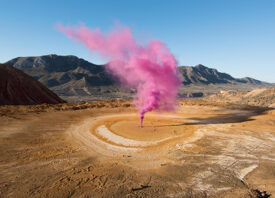Search this site
Intimate Photos of Basquiat as a Young Man

Basquiat in the apartment, 1981. Photograph by Alexis Adler.

Refrigerator in the apartment, c. 1979–1980. Photograph by Alexis Adler.
Before Jean-Michel Basquiat was known by name, his work had already hit the streets of New York. Writing under the name SAMO©, Basquiat and partner Al Diaz co-opted the means of graffiti to build street cred and fame but they took it a step further by adding tongue-in-cheek turns of phrase in bold block letters. By avoiding the highly stylistic letterforms of graffiti writers, SAMO© made it clear: they wanted to be read, known, and understood. Theirs was a message to the people of New York.
SAMO© was a name that Diaz and Basquiat came up with one day while smoking they called “the same old shit.” They shortened it to “Same old,” then “SAMO” came through. At the time, Basquiat had been working in the art department of Unique Clothing Warehouse, perfectly situated at the intersection of Broadway and West Eighth Street. At night, they’d go out bombing, leaving messages behind, letting the city know what was on their mind.
“SAMO©… THE SO-CALLED AVANT GARDE”
“SAMO©… 4 MASS MEDIA MINDWASH”
“SAMO as an alternative 2 playing art with the ‘radical chic’ sect of Daddy’s$funds’
While art critic Jeffrey Deitch described the messages as “disjointed street poetry” in a 1982 issue of Flash Art, Basquiat admitted in a video interview that first ran on ART in 1998 it was, “Teenage stuff. We’d just drink Ballantine Ale all the time and write stuff and throw bottles…”—because, in fact, he was just 18 and 19 years of age.
But then, in 1979, things changed. Basquiat and his friend Alexis Adler got a small apartment in the East Village together. The Brooklyn-native was on his own, free to explore life on his terms. Although his work as SAMO© continued through 1980, it was slowly getting phased out as Basquiat began to develop his work as a fine artist.
1979 and 1980 proved to be a period of chrysalis, as Basquiat lived and worked inside the apartment, developing a vision of art that was still rooted in the word, embracing the landscape of the city’s raw, crumbling buildings and walls. Rarely are we given a glimpse into an artist’s formative years, such as their mythologies are spackled together, then smoothed over with perfect gloss, so that we see only the finished product: the artist as genius.
This is where Basquiat Before Basquiat; East 12th Street, 1979-1980 comes into view. The exhibition, now on view at the Museum of Contemporary Art Denver through May 7, 2017, presents early works, objects, photographs, and documents of the artist during these critical years. To many those who only know Basquiat the legend, this show fills in the blanks, giving us a portrait of the artist as a young man on the verge of global success.
The photographs, taken by Alexis Adler, show us another side of Basquiat, that of a man-child in discovery of himself. The mood is one of the uninhibited freedom of youth, of the joys of your first apartment—all the more magical when the rent is only $80 a month. It’s a wondrous time when the possibilities are endless, and everything is an adventure, especially in a city as live as New York was during this era. Liberated from the constraints of school and the responsibilities of a career, we see Basquiat in a fresh state, one fueled by a passion for innovation, exploration, and discovery.
In the catalogue to accompany the show, Adler writes, “Apartment F8 was a haven for Jean to learn and explore and hone his expression as it coalesced from street tag to high art form. Jean studied my meager college library of biology and chemistry texts along with Janson’s History of Art and a book of Picasso prints that was passed on to me by a college roommate…. With no electricity or even running water—the pipes had been ripped out, scavenged, and sold as scrap metal—these buildings became infernos keeping junkies both high and warm. We were punk pioneers, homesteading in this ever-evolving remnant of the neighborhood. Art blossomed by feeding off the lawless decay.”
The stories, like the photographs and the art, fully embrace the romantic element of Basquiat’s life. At the age of 19 and 20, he was transitioning between worlds, charting a path for himself as one of the greatest artists of our time. Adler’s photographs reveal Basquiat’s comfort with self-discovery, of an innocent embrace of pleasure and absurdity. You may sense the future, but only because you already know where the story goes. It is a reminder, in the words of Orson Welles, “If you want a happy ending, that depends, of course, on where you stop your story.”

The apartment, c. 1979–1980. Photograph by Alexis Adler.

Basquiat in the apartment, 1980. Photograph by Alexis Adler.

Basquiat in the apartment, 1981. Photograph by Alexis Adler.

Basquiat in the apartment, 1980. Photograph by Alexis Adler.

Basquiat in the apartment, 1981. Photograph by Alexis Adler.

Basquiat practicing clarinet in the bathroom of the apartment, c. 1980. Photograph by Alexis Adler.

Basquiat performing in the apartment, c. 1979–1980. Photograph by Alexis Adler.

Basquiat performing in the apartment, c. 1979–1980. Photograph by Alexis Adler.

Basquiat performing in the apartment, c. 1979–1980. Photograph by Alexis Adler.

Basquiat performing in the apartment, c. 1979–1980. Photograph by Alexis Adler.

Basquiat performing in the apartment, c. 1979–1980. Photograph by Alexis Adler.

Basquiat performing in the apartment, c. 1980. Photograph by Alexis Adler.

Painted television in the apartment, c. 1979–1980. Photograph by Alexis Adler.



